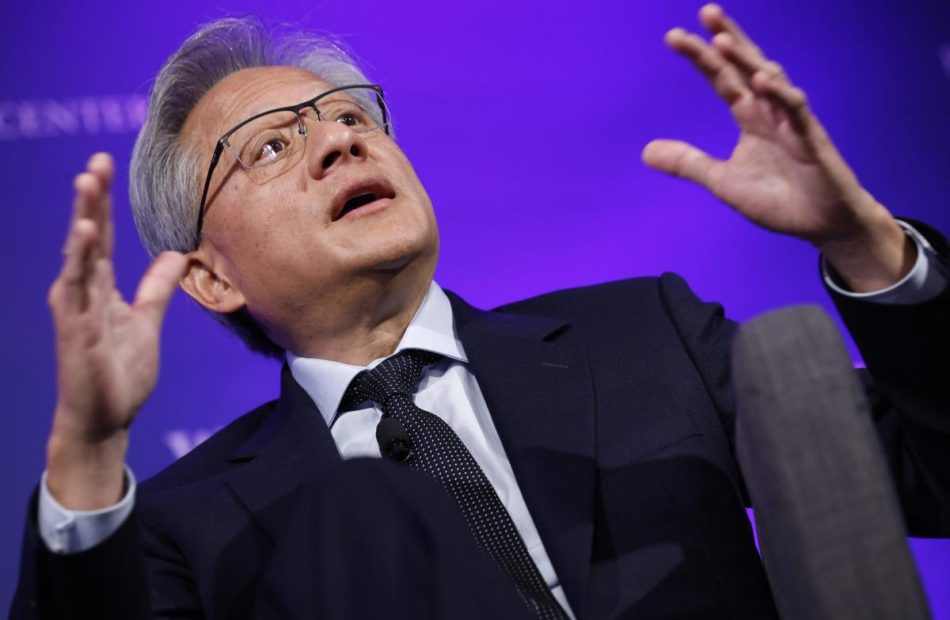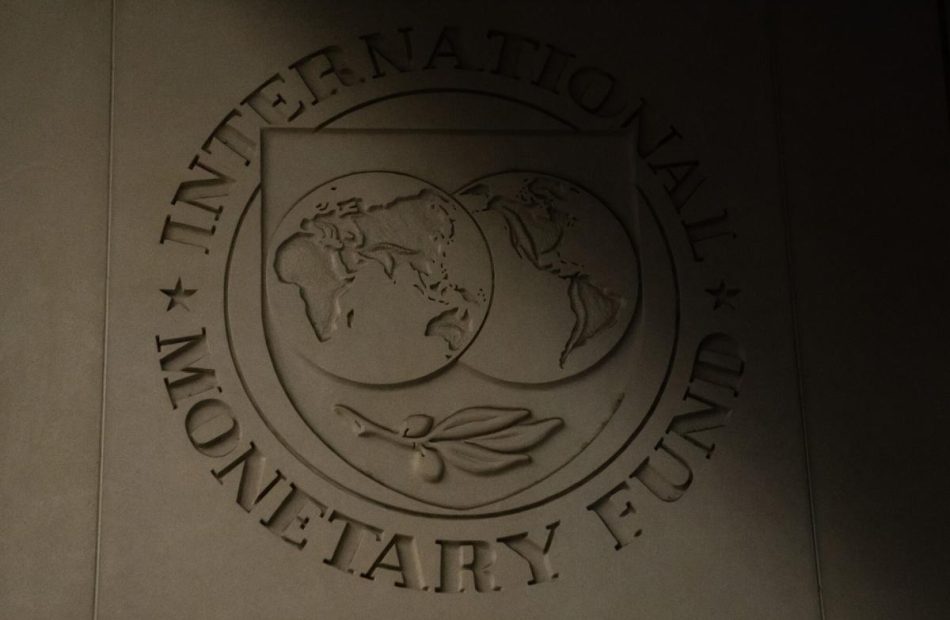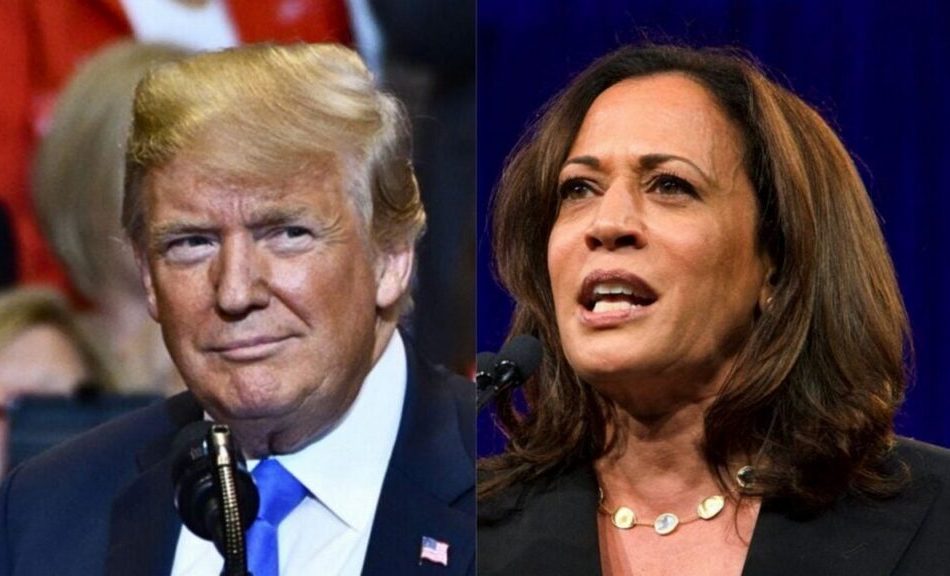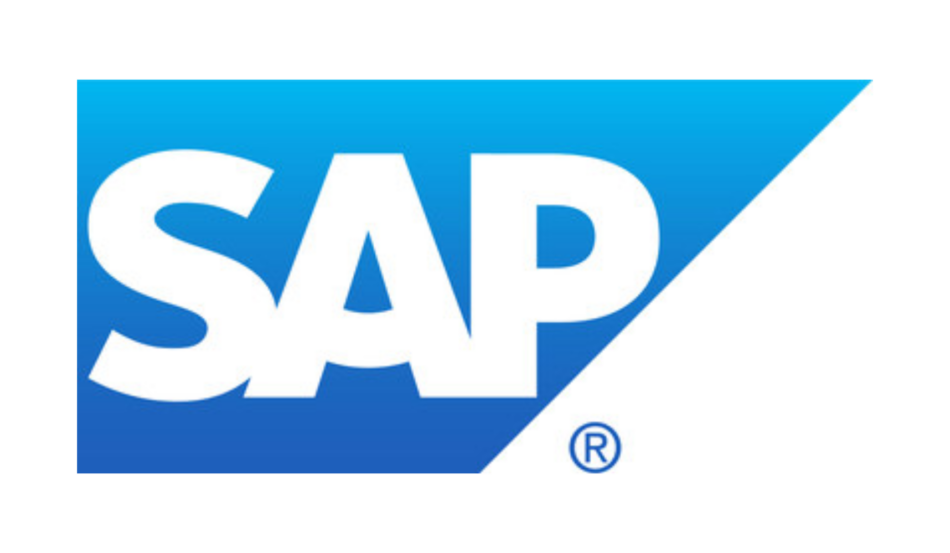Should you buy Nvidia stock now? It may be a once-in-a-generation opportunity
Nvidia has been one of the most hyped and closely followed stocks in recent memory as the fortunes of the broader market increasingly hinge on the AI chip leader.
At one point this year, the stock accounted for more than a third of the S&P 500’s gains, and some investors even held watch parties for Nvidia’s earnings release.
Nvidia’s astronomical run to a $3 trillion company has also been somewhat divisive as many on Wall Street have doubted that the stock can sustain further gains while others see the AI boom fueling more upside.
That’s left investors asking, “should I buy Nvidia stock right now, or sell it?”
Analysts at Bank of America have an answer: In a note on Thursday, they reiterated their buy rating on Nvidia stock and raised their price target to $190 from $165, implying it could soar 38% higher from Friday’s closing price.
At $190 a share, Nvidia’s market cap would also explode to $4.7 trillion from $3.4 trillion today.
In fact, BofA is so bullish on Nvidia stock that analysts called it a “generational opportunity,” estimating a total addressable market of more than $400 billion for AI accelerators.
“AI models (demand) continue to evolve, with the cadence of new LLM model launches now increased to 3-5 times/yr per developer (OpenAI, Google, Meta, etc.), and each new major generation requiring 10-20x compute requirement to train,” analysts said.
Their confidence in Nvidia has been boosted by others in the chip sector like Taiwan Semiconductor and ASML, which both recently signaled strong AI demand. BofA’s meetings with executives at Broadcom and Micron as well as comments from AMD have yielded similar indications.
Meanwhile, Nvidia CEO Jensen Huang also touted huge demand for the company’s next-generation AI chip.
“Blackwell is in full production, Blackwell is as planned, and the demand for Blackwell is insane,” he told CNBC earlier this month. “Everybody wants to have the most, and everybody wants to be first.”
Adding to BofA’s bullish case for Nvidia is its underappreciated enterprise partnerships with the likes of Accenture, ServiceNow, Microsoft, and others as well as its software products that help reinforce Nvidia’s dominance in hardware. They combine to create a deeper overall Nvidia ecosystem for AI.
Plus, Nvidia could generate more than $200 billion in free cash flow over the next two years, rivaling even Apple, BofA estimated.
Earnings reports later this month from tech giants that are developing AI technologies, such as Microsoft, Google, and Amazon, should provide more insight into demand. And Nvidia is due to report Nov. 20.
While some on Wall Street have expressed skepticism on whether massive investments in AI are translating to the bottom line, the tech sector is locked in a cutthroat race to be first on the scene with the latest advances in AI.
“We continue to see the pace of new model development increase,” BofA said. “LLMs in particular are being developed for both larger size and better reasoning capabilities, which both require greater training intensity.”
This story was originally featured on Fortune.com
Bitcoin, Ethereum, Dogecoin On The Rise As 'Uptober' May Be Finally Here: Analysts Predict Bullish Breakout For King Crypto, ETH's Rally To $3,300
Leading cryptocurrencies maintained bullish momentum over the weekend, boosting expectations for new all-time highs.
| Cryptocurrency | Gains +/- | Price (Recorded at 8:45 p.m. EDT) |
| Bitcoin BTC/USD | +1.26% | $69,123.24 |
| Ethereum ETH/USD |
+3.79% | $2,744.10 |
| Dogecoin DOGE/USD | +0.96% | $0.1444 |
What Happened: Bitcoin jumped above $69,000 late evening, a level not seen since the first week of June. The world’s largest cryptocurrency was up 8.9% in October, a month that has historically seen gains of over 21% on average.
Ethereum spiked to $2,750, the highest it has been since the August meltdown. The second-largest cryptocurrency soared nearly 12% last week.
In the past 24 hours, 56,654 traders were liquidated, with the total liquidations coming in at $134.09 million. More than $805 million in Bitcoin shorts would be wiped out if the leading cryptocurrency hits $72,000, according to Coinglass.
Bitcoin’s Open Interest rose 2.87% in the last 24 hours, while money locked in Ethereum’s futures market soared 8.84%, indicating bullish momentum.
Market sentiment was one of “Greed” as of this writing, according to the Cryptocurrency Fear & Greed Index.
Top Gainers (24-Hours)
| Cryptocurrency | Gains +/- | Price (Recorded at 8:45 p.m. EDT) |
| Apecoin (APE) | +62.30% | $1.42 |
| dYdX (DYDX) | +27.87% | $1.26 |
| Mog Coin (MOG) | +11.94% | $0.00000228 |
The global cryptocurrency stood at $2.39 trillion, following a jump of 2.20% in the last 24 hours.
Stock futures edged higher Sunday overnight. The Dow Jones Industrial Average Futures was up 53 points, or 0.13%, as of 8:45 p.m. EDT. Futures tied to the S&P 500 gained 0.12%, while Nasdaq 100 Futures added 0.14%.
The rise followed a lucrative week for blue-chip indexes, with the Dow Jones Industrial Average and the S&P 500 closing at record highs Friday. to close at a new record high of 43,239.05. The Dow was up 2.23% since October began, while the broad-based index lifted 1.77% in the same period.
Tech titans like Tesla Inc. TSLA and Amazon.com Inc. AMZN are all set to report their earnings this week, serving as important market triggers.
See More: Best Cryptocurrency Scanners
Analyst Notes: Noted cryptocurrency researcher and trader Rekt Capital stated that Bitcoin would break out from the multi-month downtrend channel toward at least $70,000 if it records a weekly close above the red resistance.
With King Crypto managing to do just that, it remains to be seen whether the analyst’s prediction is correct.
Widely followed cryptocurrency analyst Ali Martinez drew attention to the bullish pivot of the MVRV Momentum indicator, considered a “go-to” metric to evaluate Bitcoin’s trend.
Regarding Ethereum, the analyst highlighted the possibility of the coin rising to $3,300 provided the $2,660 holds.
Read Next:
Market News and Data brought to you by Benzinga APIs
© 2024 Benzinga.com. Benzinga does not provide investment advice. All rights reserved.
World’s $100 Trillion Fiscal Timebomb Keeps Ticking
(Bloomberg) — Even before global finance chiefs fly into Washington over the next few days, they’ve been urged in advance by the International Monetary Fund to tighten their belts.
Most Read from Bloomberg
Listen to the Here’s Why podcast on Apple, Spotify or anywhere you listen
Two weeks ahead of a potentially era-defining US election, and with the world’s recent inflation crisis barely behind it, ministers and central bankers gathering in the nation’s capital face intensifying calls to get their fiscal houses in order while they still can.
The fund, whose annual meetings begin there on Monday, has already pointed to some of the themes it hopes to press home with a barrage of projections and studies on the global economy in coming days.
The IMF’s Fiscal Monitor on Wednesday will feature a warning that public debt levels are set to reach $100 trillion this year, driven by China and the US. Managing Director Kristalina Georgieva, in a speech on Thursday, stressed how that mountain of borrowing is weighing on the world.
“Our forecasts point to an unforgiving combination of low growth and high debt — a difficult future,” she said. “Governments must work to reduce debt and rebuild buffers for the next shock — which will surely come, and maybe sooner than we expect.”
Some finance ministers may get further reminders even before the week is over.
UK Chancellor of the Exchequer Rachel Reeves has already faced an IMF warning of the risk of a market backlash if debt doesn’t stabilize. Tuesday marks the last release of public finance data before her Oct. 30 budget.
The UK tax office is taking a tougher approach to clawing back debts, insolvency specialists say, a bid to squeeze £5 billion ($6.5 billion) in extra revenue.
What Bloomberg Economics Says:
“For all the talk of black holes, the overall effect of Reeves budget will be a policy that’s looser, not tighter, relative to the previous government’s plans.”
—Ana Andrade and Dan Hanson, economists. For full analysis, click here
Meanwhile, Moody’s Ratings has slated Friday for a possible report on France, which faces intense investor scrutiny at present. With its assessment one step higher than major competitors, markets will watch for any cut in the outlook.
As for the biggest borrowers of all, the glimpse of the IMF’s report already published contains a grim admonishment: your public finances are everyone’s problem.
“Elevated debt levels and uncertainty surrounding fiscal policy in systemically important countries, such as China and the United States, can generate significant spillovers in the form of higher borrowing costs and debt-related risks in other economies,” the fund said.
Elsewhere in the coming week, a rate cut in Canada and a hike in Russia are among the possible central bank moves anticipated by economists.
Click here for what happened in the past week, and below is our wrap of what’s coming up in the global economy.
US and Canada
Economists see a pair of home sales reports showing that declining mortgage rates are merely helping to stabilize the US residential real estate market. On Wednesday, the National Association of Realtors will issue data on contract closings for previously owned homes, followed a day later by government figures on sales of new homes.
Economists project modest increases in September sales of both existing and new homes. Resales remain hamstrung by limited inventory that’s keeping asking prices elevated and hurting affordability. While purchases of previously owned properties remain near the weakest pace since 2010, builders have capitalized: New-home sales have gradually picked up over the past two years with the help of incentives.
Other US data in the coming week include September durable goods orders, plus capital goods shipments that will help economists fine-tune their estimates of third-quarter economic growth. The Federal Reserve also issues its Beige Book, an anecdotal readout of the economy.
Regional Fed officials speaking in the coming week include Jeffrey Schmid, Mary Daly and Lorie Logan.
Meanwhile, the Bank of Canada is increasingly expected to cut rates by 50 basis points after inflation cooled to 1.6% in September and some measures of the labor market remain weak.
Europe, Middle East, Africa
As with other regions, attention will largely be focused on Washington; more than a dozen appearances of European Central Bank’s Governing Council members are scheduled stateside.
That includes President Christine Lagarde, who’ll be interviewed by Bloomberg Television’s Francine Lacqua in Washington on Tuesday.
Similarly, Bank of England Governor Andrew Bailey will speak in New York on Tuesday, while Swiss National Bank President Martin Schlegel is scheduled to appear on Friday.
Among euro-area economic reports, consumer confidence on Wednesday, purchasing manager indexes the following day, and the ECB’s inflation expectations survey on Friday may be the highlights. Similarly, Germany’s Ifo Institute will release its closely watched business confidence gauge at the end of the week.
Aside from the possible rating assessment on France, S&P may also release reports on Belgium and Finland on Friday.
Turning east, two central bank decisions are likely to draw attention, starting on Tuesday with Hungary, which may keep borrowing costs unchanged.
The Bank of Russia has signaled that continued inflationary pressures could lead to another rate hike on Friday. They lifted it 100 basis points to 19% in September, and a similar move would return the rate to the 20% level imposed in an emergency increase after President Vladimir Putin began the February 2022 full-scale invasion of Ukraine.
Finally, data on Wednesday from South Africa is expected to show inflation slowed to 3.8% in September, boosting the chances of another rate cut next month. The central bank said it now forecasts consumer-price growth to stay in the bottom half of its 3% to 6% target band over the next three quarters.
Asia
Lenders in China, with a nudge from the People’s Bank of China, are expected to join the campaign to revive business activity by trimming their loan prime rates on Monday. The 1-year and 5-year rates are seen sliding by 20 basis points to 3.15% and 3.65%, respectively.
At the end of the week, data will show if the nation’s industrial profits bounced back in September after slumping more than 17% in August. The most recent numbers showed the economy expanding at the lowest pace in six quarters during that three-month period.
Elsewhere, the region gets a cluster of PMIs on Thursday, including from Japan, Australia and India.
Singapore is forecast to report Wednesday that consumer inflation slowed in September, with price growth updates for that month also due from Hong Kong and Malaysia.
On Friday, Japan will report Tokyo CPI for October, a key indicator that will capture corporate price changes at the start of the fiscal second half.
South Korea will release third-quarter growth figures on Wednesday that may show the economy’s momentum has slowed marginally.
During the week, South Korea releases early trade statistics for October, with Taiwan and New Zealand releasing trade numbers for September.
Among the region’s central banks, many leading officials will attend the IMF meetings in Washington. Reserve Bank of Australia Deputy Governor Andrew Hauser holds a fireside chat on Monday, and three days later the bank publishes its annual report.
Reserve Bank of New Zealand chief Adrian Orr speaks on policy on the sidelines of the IMF confab, and Uzbekistan’s central bank will decide Thursday whether to pause for a second meeting following its July rate cut.
Latin America
Brazil watchers will be keen to see the weekly forecasts in the central bank’s so-called Focus survey due on Monday.
Expectations for inflation, borrowing costs and debt metrics have lately taken a decidedly gloomy turn given doubts about the government’s fiscal discipline.
In Mexico, GDP proxy data should be consistent with the loss of momentum that has many economists marking down their third-quarter growth forecasts. The economy is expected to slow for a third year in 2024.
GDP proxy data for Argentina will probably show South America’s second-biggest economy sputtering and still in the grip of a recession that’s likely to extend into 2025.
Paraguay’s central bank holds its rate setting meeting; policymakers have kept borrowing costs at 6% for the past six months with inflation running slightly above the 4% target.
On the prices front, neither investors nor policymakers will be cheered by mid-month inflation reports from Brazil and Mexico given the early consensus for higher headline readings.
The data here will likely do nothing to dent the prospects of Brazil’s central bank tightening policy again on Nov. 6, while at the same time giving Banxico pause about a third straight cut at its Nov. 14 gathering.
–With assistance from Laura Dhillon Kane, Brian Fowler, Robert Jameson, Monique Vanek, Vince Golle, Brendan Scott and William Horobin.
(Updates with UK tax office in eighth paragraph)
Most Read from Bloomberg Businessweek
©2024 Bloomberg L.P.
Nvidia stock is in beast mode again!
This is The Takeaway from today’s Morning Brief, which you can sign up to receive in your inbox every morning along with:
I have never been one to have a cluttered desk at work.
To me, everything has a place. Awesome desk organization, awesome outcomes, is how my head works.
But I broke this rule slightly by the close of trading on Friday. Going forward, I will have a paper cutout of Nvidia (NVDA) CEO Jensen Huang in his trademark leather jacket thumbtacked to the wallboard (see pic below). And I’ll tell you why.
For one full day this week I forgot to check Nvidia’s stock price my usual 10 times a day — only checking in five times. I let myself (and you all) down because, in the blink of an eye, Nvidia’s stock went from a quick sell-off from the Monday record highs back to those same highs come the end of the week.
I missed it!
The stock is up 13% in October, dusting the 1.4% gain for the S&P 500. AMD’s (AMD) stock is down by 5% this month, similar to Intel (INTC).
So Jensen’s face on my desk is a reminder to check in with Nvidia’s stock price and fundamentals numerous times a day. And to ask everyone I encounter about Nvidia, even people not in the chip space (as I did at one annual CEO dinner this week hosted by ServiceNow’s (NOW) CEO Bill McDermott).
Here’s what I was reminded of by recommitting to an Nvidia obsession: Something insanely bad from a company-specific perspective will be the only thing taking this market darling down for any prolonged period of time. To be honest with you, I don’t see where that insanely bad stuff would sprout from over the next few quarters.
Neither do the array of plugged-in characters I chat up each week.
“I don’t think when you get to Nvidia, there is any hype at all. I have known Jensen for decades, and he is the real deal. What these guys are doing is very real and very powerful,” C3.ai (AI) founder and CEO Tom Siebel told me on Yahoo Finance’s Opening Bid podcast (video above; listen in below).
Hey Sam Altman, you should watch what Siebel thinks about your latest valuation…
Anyhow, Hewlett Packard Enterprise (HPE) CEO Antonio Neri has known Jensen for ages. I didn’t get the sense Nvidia’s products were anything but super hot sellers in a chat with him, yours truly, and Seana Smith on Yahoo Finance’s Catalysts.
“When you think about the large-scale [cloud] providers, what they want is to come to market with the latest technologies. And obviously, Blackwell is a key component of that as they go from air-cooled to the liquid cooling, more power density and more performance, and they are on track to do that,” Neri said about Nvidia.
Speaking of Blackwell — Nvidia’s new ultra-high-powered AI chip — the analyst community feels as if they are readying to jack up their fourth quarter profit forecasts on better-than-expected demand.
“We believe demand is outstripping supply for Nvidia 15:1, and the Street is realizing this AI party is still at 9 pm and being led by the Godfather of AI Jensen and Nvidia. TSMC had monster [earnings] numbers, and Blackwell looks like an Aaron Judge debut coming out of the gates,” Wedbush analyst Dan Ives told me.
The JPMorgan team estimates “several billion dollars” in Blackwell revenue in Nvidia’s fourth quarter. Huge if it happens, underscoring the appetite to build out AI infrastructure.
Believe me, I look at Nvidia very critically, just like all the companies I report on.
But geez, it sure looks as if Nvidia being back in beast mode makes a lot of sense — as does having a cutout of Jensen at my desk.
“Jensen is an innovator, great leader, great operator. You can’t count those guys out of anything,” Siebel added.
Three times each week, I field insight-filled conversations with the biggest names in business and markets on Opening Bid. Find more episodes on our video hub. Watch on your preferred streaming service. Or listen and subscribe on Apple Podcasts, Spotify, or wherever you find your favorite podcasts.
Brian Sozzi is Yahoo Finance’s Executive Editor. Follow Sozzi on X @BrianSozzi and on LinkedIn. Tips on deals, mergers, activist situations, or anything else? Email brian.sozzi@yahoofinance.com.
Click here for the latest technology news that will impact the stock market
Read the latest financial and business news from Yahoo Finance
Trump Leads Harris — Ex-President Improves Polling Averages In These 2 Key Battleground States, Poll Shows
Former President Donald Trump has surpassed Vice President Kamala Harris in a latest election poll for the current cycle.
What Happened: The Decision Desk HQ/The Hill forecast model now gives Trump a 52% chance of winning the presidency, compared to Harris’s 42%, according to a report from The Hill. This is a significant shift from late August when Harris was leading with a 54 to 56% chance, and Trump was trailing with a 44 to 46% chance.
The dynamics began to change in early October, with both candidates’ chances predicted to be closer to 50%. By October 17, the model predicted an equal likelihood of either candidate winning the upcoming election. Trump took the lead on October 20.
This shift aligns with Trump’s improved polling averages in Wisconsin and Michigan, two battleground states that previously leaned slightly toward Harris. Trump already held a slim advantage in Arizona, Georgia, and North Carolina.
However, Pennsylvania, one of the seven swing states seen as decisive in the 2024 election, still favors Harris in its polling average. Despite the shifts, the race remains a toss-up, with polling in all seven states within the margin of error.
These states are crucial in determining which candidate secures the necessary 270 electoral votes. Currently, neither Trump nor Harris has a clear lead in enough states to secure that number.
Why It Matters: The recent shift in the election forecast comes after a period of narrowing leads and tightening races. Harris had been maintaining a lead over Trump in many election polls until recent weeks.
By October 19, a Benzinga report highlighted a close matchup between Trump and Harris, with election polls predicting a tight race. The recent forecast shift underscores the volatility and uncertainty of the 2024 presidential election.
Image via Shutterstock
Did You Know?
This story was generated using Benzinga Neuro and edited by Shivdeep Dhaliwal
Market News and Data brought to you by Benzinga APIs
© 2024 Benzinga.com. Benzinga does not provide investment advice. All rights reserved.
Mark Cuban Calls Warren Buffett's Buy-And-Hold Strategy A 'Crock' – Which Billionaire's Investment Style Aligns With Your Goals?
Mark Cuban’s bold claim that Warren Buffett’s famous buy-and-hold strategy is a “crock” has reignited debates within the investing community.
Cuban, known for his unapologetic views and a net worth surpassing $5 billion, isn’t shy about challenging established investment philosophies. His thoughts on diversification, particularly, stir the pot among traditional investors, with a growing number backing his aggressive approach.
Don’t Miss:
According to Buffett, “diversification is a protection against ignorance,” a guiding principle that’s long been at the heart of his investment strategy. Buffett’s approach leans on the idea that spreading your money across various assets can shield against market downturns.
For many retail investors, index funds are the go-to for diversification. These funds mimic broad market indexes to provide a stable, if not flashy, return over time.
On the other hand, Cuban cuts through the noise with a more concentrated strategy. He’s famously said that “diversification is for idiots” and that the buy-and-hold strategy embraced by Buffett devotees is essentially worthless.
Trending:This Adobe-backed AI marketing startup went from a $5 to $85 million valuation working with brands like L’Oréal, Hasbro, and Sweetgreen in just three years – here’s how there’s an opportunity to invest at $1,000 for only $0.50/share today.
Cuban’s view resonates with some investors who are laser-focused on beating the market rather than merely matching it. According to Morningstar research, professional money managers who outperform benchmarks often make big, bold bets – not by playing it safe with a diverse portfolio.
For investors grappling with which billionaire to follow, a look at the numbers might help. Cambridge Associates’ 2017 study supports diversification: “Diversified portfolios still prevail over the long term,” the report says, suggesting that a diverse strategy might cushion portfolios against severe market drops and provide more consistent returns over decades. This echoes Buffett’s success with slow and steady wealth-building.
Trending: Warren Buffett once said, “If you don’t find a way to make money while you sleep, you will work until you die.” These high-yield real estate notes that pay 7.5% – 9% make earning passive income easier than ever.
But not everyone is convinced. Cuban’s strategy, which focuses more on tech and innovative industries, has paid off handsomely in a world increasingly reliant on technology. He believes focusing on a few high-conviction bets will generate better returns, a sentiment shared by other billionaire investors.
Real estate often emerges as a contender for those seeking alternatives to the traditional stock market. High home prices and mortgage rates have made owning property trickier, but the allure of steady rental income hasn’t faded.
See Also: ‘Beating the market through ethical real estate investing’ — this platform aims to give tenants equity in the homes they live in while scoring 17.38% average annual returns for investors – here’s how to join with just $100
Meanwhile, data from Nareit shows that commercial real estate offers steady returns and lower volatility than stocks. The numbers speak volumes – commercial real estate has a lower correlation to the S&P 500, making it a useful hedge for many investors.
And if real estate doesn’t entice, fine art might. According to data from the Citi Global Art Market chart and as cited by CNBC, contemporary art outperformed the S&P 500 over the last two decades, with annual returns of 11.5% compared to the market’s 9.6%. Cuban’s strategy might inspire you to look at alternatives like blue-chip art, which offers unique opportunities beyond stocks.
Read Next:
UNLOCKED: 5 NEW TRADES EVERY WEEK. Click now to get top trade ideas daily, plus unlimited access to cutting-edge tools and strategies to gain an edge in the markets.
Get the latest stock analysis from Benzinga?
This article Mark Cuban Calls Warren Buffett’s Buy-And-Hold Strategy A ‘Crock’ – Which Billionaire’s Investment Style Aligns With Your Goals? originally appeared on Benzinga.com
© 2024 Benzinga.com. Benzinga does not provide investment advice. All rights reserved.
SAP, Nucor And 3 Stocks To Watch Heading Into Monday
With U.S. stock futures trading mixed this morning on Monday, some of the stocks that may grab investor focus today are as follows:
- Wall Street expects SAP SE SAP to report quarterly earnings at $1.33 per share on revenue of $9.29 billion after the closing bell, according to data from Benzinga Pro. SAP shares gained 0.2% to $230.87 in after-hours trading.
- Public Storage PSA named Chris Sambar as COO. Public Storage shares gained 0.1% to close at $345.62 on Friday.
- Analysts are expecting Nucor Corporation NUE to post quarterly earnings at $1.47 per share on revenue of $7.28 billion. The company will release earnings after the markets close. Nucor shares gained 0.1% to close at $158.24 on Friday.
Check out our premarket coverage here
- The Cigna Group CI shares fell in after-hours trading after a report suggesting the company has resumed merger discussions with Humana Inc. HUM after the conversation ended last year. Cigna shares fell 4.7% to $320.26 in the after-hours trading session.
- Analysts expect Logitech International S.A. LOGI to report quarterly earnings at 99 cents per share on revenue of $1.11 billion after the closing bell. Logitech shares rose 1.2% to close at $88.63 on Friday.
Check This Out:
Photo courtesy: SAP
Market News and Data brought to you by Benzinga APIs
© 2024 Benzinga.com. Benzinga does not provide investment advice. All rights reserved.
Gary Black Explains Why He Doesn't Factor In Robotaxi Or Optimus To Tesla Valuation: Investors May Not Like Analytical Approach, But That's How 'Investment World Works'
Tesla Inc. TSLA continues to face significant headwinds in its automotive business, with concerns mounting over sustained margin pressure and underperformance against broader tech indices, according to an analysis from The Future Fund LLC.
What Happened: Gary Black, managing partner at The Future Fund, emphasizes his firm’s analytical approach to valuation, notably excluding potential revenue from robotaxis and Optimus until competitive dynamics and economics become clearer.
Black, highlighted Tesla’s recent underperformance, noting a 24% decline against the Nasdaq 100’s 32% gain over three years. However, Future Fund maintains a long position in Tesla, citing robust global EV adoption trends and expansion opportunities.
“Global EV adoption continues to surge, from 15% today to 50% by 2030, representing a 25.8% CAGR,” Black noted on X, formerly Twitter. The firm projects Tesla can maintain its market share by entering new segments, including a $25-30K compact vehicle, robotaxi services, and small pickups.
Future Fund’s detailed valuation model includes:
- 2030 delivery target of 8.8 million vehicles
- Projected adjusted EPS of $15.00
- Price target of $270, based on a 1.5x PEG ratio and 25% forward EPS growth
- 2030 valuation of $562, discounted at a 14.2% cost of equity
“We realize many $TSLA investors disdain our analytical-based approach to TSLA valuation, but that’s how the investment world works. One can’t just make up valuations out of thin air.” Black wrote.
Black explained that The Future Fund models EV demand and market share, FSD adoption rates, energy, and services. However, they refrain from including Robotaxi or Optimus in their valuation until they can evaluate the competitive dynamics and economics of these future products.
The firm believes that multiple automakers will be approved for generalized unsupervised autonomy around the same time, suggesting that a demand-driven model is more appropriate for valuation rather than a supply-driven one.
Near-term challenges include:
- Auto loan interest rates of 0.99% globally
- Negative Cybertruck margins
- Limited scale production, with Q3 Cybertruck deliveries estimated at 13,500 units
See Also: Palantir Technologies Unusual Options Activity
Why It Matters: Tesla’s financial performance is crucial as the company navigates a series of strategic shifts. Recently, Tesla showcased its Optimus humanoid robot, demonstrating advancements in autonomous navigation and charging capabilities.
This move aligns with Tesla’s broader vision for autonomy, a field where Waymo co-founder Anthony Levandowski sees Tesla having an edge due to its extensive data collection.
Additionally, Tesla’s recent executive promotions indicate a strategic realignment to bolster its sales and manufacturing operations.
These developments come as Gene Munster from Deepwater Asset Management discusses Tesla’s ambitious plans for robotaxis, which could revolutionize transportation and save significant time and resources.
Price Action: Tesla Inc. closed at $220.70 on Friday, down 0.086%. In after-hours trading, the stock further declined 0.25%. Year to date, Tesla’s stock has decreased by 11.16%, according to data from Benzinga Pro.
Read Next:
Image Via Shutterstock
Disclaimer: This content was partially produced with the help of AI tools and was reviewed and published by Benzinga editors.
Market News and Data brought to you by Benzinga APIs
© 2024 Benzinga.com. Benzinga does not provide investment advice. All rights reserved.
1 Digital Banking Stock Down 61% to Buy and Hold Forever
SoFi Technologies (NASDAQ: SOFI) is on a roll. The stock recently soared to $10 per share, its highest price since early 2022. It’s progress, but the stock is still down about 60% from its all-time high, set during the market bubble in 2021. SoFi is a digital bank, but it’s not exactly a banking stock. (Well, it’s not a traditional bank stock.)
So, just what is SoFi? It could be an industry disruptor with traditional banking features and the added upside of a technology company.
Here are five reasons investors should consider buying SoFi Technologies and tucking it away for the foreseeable future.
1. It’s wildly popular among consumers
On the surface, SoFi Technologies is a digital bank. It offers banking services, loans, and financial products through its website and smartphone app. Unlike many longstanding banks, SoFi doesn’t have any physical branches. It’s a business model born in the digital age. More importantly, SoFi has become quite popular. The company’s customer base has grown from 1.4 million at the start of 2020 to nearly 8.8 million today.
SoFi’s customer count grew 41% year over year in the second quarter, so this trend still has plenty of momentum. SoFi has become especially popular with young, high-earning adults. This is one of the most valuable customer segments in the financial sector, because they will drive the economy over the coming decades.
2. More than a bank
Behind the curtain, SoFi has financial technology in its DNA. In 2020, it acquired Galileo, a fintech company that provides payment processing, card issuing, and embedded finance services to over 100 companies, including H&R Block, Toast, MoneyLion, and others, across 16 countries. Collectively, Galileo’s customers add up to 158 million accounts.
SoFi’s technology platform segment (Galileo) grew its contribution profit by 24% last year, representing about 10% of the company’s total in 2023. Additionally, Galileo accounts have quintupled since the first quarter of 2020. Over time, Galileo could become a more significant contributor to SoFi’s business and expose investors to broader growth across the fintech industry.
3. Student loan upside
SoFi started in the student loan business and built a reputation in refinancing. In 2019, SoFi originated $6.7 billion in loans. However, a federal student loan freeze for most of the past four years and higher interest rates since 2022 have effectively cratered demand for refinancing. SoFi’s student loan originations were just $2.6 billion in 2023, despite it adding millions of customers since 2019.
It looks like the worst is past. The federal freeze is virtually over, and interest rates have seemingly peaked. Meanwhile, analysts estimate that the private student loan market could grow by 10% annually through the early 2030s. SoFi’s student loan business could uncoil like a spring and boost growth over the coming years.
4. SoFi could lean into fee-based revenue
SoFi may not operate quite like a traditional bank over the long term. Traditional banks hold loans on their balance sheets and collect the interest. The risk of default affects how the market values bank stocks compared to most other businesses. Galileo already represents a non-lending component of SoFi’s business, but things got more interesting recently.
Just days ago, SoFi announced an agreement to expand its personal lending business with a $2 billion funding agreement with Fortress Investment Group. Simply put, SoFi will underwrite personal loans but then offload them. SoFi will miss out on the interest income, but it will reduce its balance sheet risk. CEO Anthony Noto commented in the press release, noting an intention to grow SoFi’s fee-based revenue. Holding fewer loans on its books could affect how the market values SoFi stock.
5. Earnings growth is set for lift-off
I often use book value to evaluate bank stocks, but Galileo and a potentially less lending-dependent business model make earnings a viable way to value SoFi stock. SoFi reported a GAAP profit for the third consecutive quarter in Q2 2024. The company is right at that sweet spot where operating leverage (when revenue grows faster than expenses) causes high-speed earnings growth.
Analysts estimate that SoFi will grow earnings by an average of 51% annually for the next three to five years. Given SoFi’s popularity and growth opportunities, I wouldn’t be surprised to see the company enjoy strong earnings growth for the foreseeable future. The stock looks like a candidate to perform well for investors as those earnings compound for years to come.
Don’t miss this second chance at a potentially lucrative opportunity
Ever feel like you missed the boat in buying the most successful stocks? Then you’ll want to hear this.
On rare occasions, our expert team of analysts issues a “Double Down” stock recommendation for companies that they think are about to pop. If you’re worried you’ve already missed your chance to invest, now is the best time to buy before it’s too late. And the numbers speak for themselves:
-
Amazon: if you invested $1,000 when we doubled down in 2010, you’d have $21,285!*
-
Apple: if you invested $1,000 when we doubled down in 2008, you’d have $44,456!*
-
Netflix: if you invested $1,000 when we doubled down in 2004, you’d have $411,959!*
Right now, we’re issuing “Double Down” alerts for three incredible companies, and there may not be another chance like this anytime soon.
*Stock Advisor returns as of October 14, 2024
Justin Pope has no position in any of the stocks mentioned. The Motley Fool has positions in and recommends Toast. The Motley Fool has a disclosure policy.
1 Digital Banking Stock Down 61% to Buy and Hold Forever was originally published by The Motley Fool
Oklo, CleanSpark And Wolfspeed Are Among Top 7 Mid Cap Gainers Last Week (Oct 14-18): Are The Others In Your Portfolio?
These seven mid-cap stocks were the best performers in the last week. Are they in your portfolio?
- Oklo Inc.’s OKLO stock gained 99.23% last week. Nuclear-linked stocks gained after Amazon Inc.’s AMZN AWS announced plans to invest over $500 million in nuclear power.
- Wave Life Sciences Ltd. WVE shares jumped 67.35% after the company achieved its first-ever therapeutic RNA editing in humans from its RestorAATion-2 trial of WVE-006 for Alpha-1 antitrypsin deficiency. Several analysts raised the price target on the stock.
- Longboard Pharmaceuticals, Inc. LBPH gained 52.21% after the company announced it would be acquired by Lundbeck for $60 per share in cash.
- Wolfspeed, Inc. WOLF shares rocketed 42.44% after signing a non-binding preliminary memorandum of terms for up to $750 million in proposed direct funding under the CHIPS and Science Act.
- CleanSpark, Inc. CLSK stock upped 34.10% last week after Bitcoin BTC/USD rose above $67,000.
- Telephone and Data Systems, Inc. TDS soared 26.03% after the company announced its subsidiary, United State Cellular Corp USM, selling select spectrum licenses in the AWS and PCS bands.
- IonQ, Inc. IONQ shares increased 15.31%. The company will report third-quarter financial results on November 6.
Also Read:
Photo Courtesy of Oklo
Market News and Data brought to you by Benzinga APIs
© 2024 Benzinga.com. Benzinga does not provide investment advice. All rights reserved.










